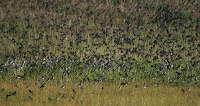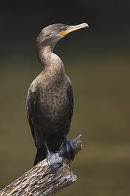
It started around August 12th or so. The numbers of Tree Swallows sweeping over each body of water, from the slough, to the pond, to the newer containment pond have been increasing steadily over the month. Swallows, whose families probably were raised in tree holes found in the woods around the bog, have come together as one. And how they delight me. I always have to stop in my tracks and look up, amazed at the swirl of iridescent green and white going on over my head. I stop because I know in just a few weeks time, this show, at least on the bog, will be over.

When they disappear from the bog though, there is a good chance I will find them with thousands more who will gather for their final staging on the dunes of Sandy Neck Beach, just a few miles from here. Going to see them there is one of the highlights of the fall. Of all the swallows, this is the one swallow who has extended it’s menu to include, not just insects, but the fruit of the bayberry bushes, small wax coated seeds that fuel them with the extra oomph they need to power themselves down the coast. They are often found on barrier beaches, dining as they make their way south. A much easier way to go, then say, some poor hummingbird that has to cross the Gulf of Mexico on nothing but the memory of the last nectar it sipped. Migration, of any species, should make us once again, be thankful for our, “drive as you go”, human status.
The other birds that are ever more present are the Robins. “Perp, perp perping”, greets me from the Tupelo trees on the eastern side of the bog as I round that bend. It seems when I go at about 7 am I am catching the early morning commute as they leave the roost of the night before and fan out in search of black cherries, tupelo seeds or of course, the worm that lurks beneath your grass.

But they too are doing spirited dives and chases that lets you know the tempo of the flock is rising as they get closer to saying “Adios” and head south. On the Cape, we have a treat of not being robin-less in winter though, for the Canadian Robin, a slightly more robust version of our Robin considers us “South of the Border” and they roost in spectacular numbers in a cedar forest near here. It is the awaited event of Dec and Jan, and when it does happen, surely you will hear about it.
More Sandpipers, Solitary and not so are “peep, peeping” at the edge of that containment pond. I know the sand flats at the ocean are sporting, or so I read, thousands of mixed migrant flocks of terns and sandpipers and all those returning from the north, now headed south, so my paltry little 5 or 6 are nothing. But they are my 5 or 6 and they are right out the back door, so they will have to do. I never seem to have the free time to get further down the Cape in the fall when it is so spectacular and the article is always pretty vague about where said “sand flats” are. I guess I should just know. Something to try to get my “ladies” to before fall is over.
The family of Red Tail hawks has to move over, literally, for the wave of migrant hawks that are also headed this way. I saw the large young Red Tail, actually move off its perch when a Sharp-Shinned Hawk landed on the same branch. Please, a little more dignity! A Sharp Shinned Hawk is a little smaller than a crow, and yes, it eats other birds, but not Red Tails! A Red Tail in need of a “self-esteem” seminar!


Round the later-summer crowd out with a pair of young Cormorants on the pond and the juvenile Great Blue Heron that entertained me last week with his arduous swallowing of a frog and you have the look of the bog, avian wise, at the end of August. I seem to hardly even notice the crows, which for awhile, after so many of these leave, will be the main entertainers.

Wherever you are, take notice of who is gathering and who is going and who, “Hey how did that happen”, is already gone. I always feel put out when the catbird that has serenaded me all summer leaves without so much as a “bye your leave.” Enjoy then, the end of heat is nigh, the bursts of color are about to begin, we see it already in the red branch here or there of Tupelo, and the little two legged dears will be back in school. A change of season is at hand once again and we are blessed to witness it aren’t we?














